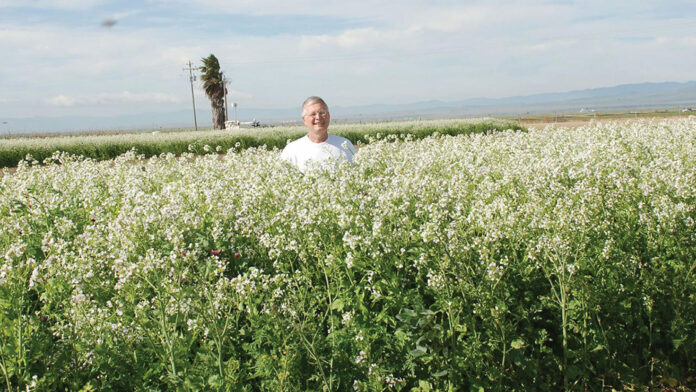⋅ BY MICHAEL HSU ⋅UNIVERSITY OF CALIFORNIA DAVIS
Jeffrey Mitchell, the study’s lead author and a professor of UCCooperative Extension in the UC Davis Department of PlantSciences, stands amid cover crops in the project field in 2010.COURTESY OF JEFFREY MITCHELL
In the 1990s, long before “regenerative agriculture” was a buzzword and “soil health” became a cause célèbre, a young graduate student named Jeff Mitchell first learned about similar concepts during an agronomy meeting in the Deep South.
Mitchell was astonished to hear a long list of benefits attributed to practices known internationally as “conservation agriculture” — eliminating or reducing tillage, cover cropping and preserving surface residues (the plant debris left after harvest). Potential benefits include saving farmers money on fuel and equipment maintenance, improving soil vitality and water dynamics, decreasing dust in the air and a host of other ecosystem services.
“All of these things start adding up and you kind of scratch your head and say, ‘Well, maybe we ought to try some of this,’” recalled Mitchell, who became a University of California Cooperative Extension cropping systems specialist at UC Davis in 1994 and is a professor in the Department of Plant Sciences.
In 1998, Mitchell launched a long-term study of those practices at the West Side Research and Extension Center in Five Points, Fresno County.
“We started this because, way back when I first began my job, nobody was doing this,” he explained. “This was brand-new, uncharted territory for California.”
For the next 20 years, Mitchell and his colleagues studied changes to the soil and ecosystem, learned from their failures and successes, and shared those hard-won lessons with fellow scientists and farmers across the state. A summary of their findings was recently published in the journal California Agriculture.
‘No Trivial Undertaking’
Mitchell and the Conservation Agriculture Systems Innovation Workgroup — a network established in 1998 comprising farmers, researchers, public agency personnel and members of private entities and environmental groups — started with a virtually blank slate. According to Mitchell, surveys at the beginning of the 21st century found that conservation agriculture practices were used on less than one-half of 1% of annual crop acreage in California.
Although no-till is common in the Midwest and Southeast, it was almost unheard of in the Golden State. With the development of irrigation infrastructure in the 1920s, California farmers saw continually phenomenal growth in yield over the last century, and thus had little incentive to deviate from tried-and-true methods that relied on regular tillage.
Nevertheless, intrigued by the potential benefits of conservation agriculture, Mitchell wanted to see which of those practices could be feasibly applied to California cropping systems. During the 20-year study at West Side REC, the researchers grew a rotation of cotton-tomato, followed by a rotation of garbanzo, melons, and sorghum, and finally tomatoes.
But at first, it was a struggle to grow anything at all — as they had to master the basics of how to establish the plants in a no-till, high-residue system.
“This was no trivial undertaking,” Mitchell said. “Early on we struggled. We failed the first couple of years because we didn’t know the planting techniques and we had to learn those. There was an upfront, very steep learning curve that we had to manage and overcome.”
Change Comes Slowly
Then there was the long wait to see any measurable improvements to soil health indicators, such as the amount carbon in the soil.
“For the first eight years, we didn’t see any changes whatsoever,” Mitchell said. “But then they became strikingly different between the no-till cover crop system and the conventional field without cover crops, and the divergence between those two systems became even starker.”
Sarah Light, UCCE agronomy farm advisor for Sutter, Yuba and Colusa counties and a co-author of the recent California Agriculture paper, said, “It’s so hard to capture measurable changes in soil health and soil function metrics through research because those changes are really slow. Often in the course of a three-year grant, you don’t actually get statistically significant differences.”
An Enduring Legacy
“The number of students who have been trained by and through this study has been really phenomenal,” Mitchell said.
He said their contributions will be essential in continuing to refine and optimize these practices that are fundamental to conservation agriculture.
To read the entire report, go to rb.gy/hywy5p.
